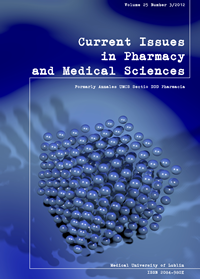Theoretical and experimental analytical studies on potassium clavulanate
DOI:
https://doi.org/10.12923/j.2084-980X/25.3/a.21Keywords:
potassium clavulanate, identification, determination, FT-IR, D-UV, DSC, TLC, HPLC-DADAbstract
The spectral and chromatographic procedures (FT-IR, D-UV, TLC, DSC, HPLC-DAD) were developed as alternative tools, to these which are recommended by pharmacopeial guidelines, for identification of potassium clavulanate. As a support for the studies quantum chemical calculations based on the density functional theory (DFT) were used. For a determination of potassium clavulanate in the presence of degradation products two analytical methods were determined: HPLC-DAD and derivative spectroscopy. In the HPLC-DAD method, C-18 stationary phase and 12 mM ammonium acetate-acetonitrile (96:4 V/V) were used. A quantitative determination of potassium clavulanate was carried out by using PDA detector at 220 nm, with a flow rate of 1.0 mL min-1. In derivative spectroscopy the change of values of amplitudes of potassium clavulanate and the first-derivative absorption spectra were used (λ=228 nm) for its determination.
References
1. Aronoff S. et al.: Comparative activites of the beta-lactamase inhibitors YTR 830, sodium clavulanate and sulbactam combined with amoxicillin or ampicillin. Antimicrob. Agents Chemther. 24(4), 580, 1984.
2. Bush K.: Characterization of beta-lactamases. Antimicrob. Agents Chemother. 33(3), 259, 1989.
3. British Pharmacopeia, British Pharmacopoeia Commission, 2005.
4. Bobrowska-Grzesik E: Determination of amoxicillin and clavulanic acid in some pharmaceutical preparation by derivative spectroscopy, Microchim. Acta. 31(34), 1,2001.
5. England K. et al.: Meropenem-clavulanic acid shows activity against Mycobacterium tuberculosis in vivo. Antimicrob. Agents Chemother. 56(6), 3383, 2012.
6. Gaussian 03, Revision B.05, 2003.
7. Holzgrade U.: Meropenem-clavulanate: a new strategy for the treatment of tuberculosis. ChemMedChem. 4(7), 1051, 2009.
8. Hugonnet J. et al.: Meropenem-clavulanate is effective against extensively drug-resistant Mycobacterium tuberculosis. Science. 323(5918), 1215, 2009.
9. ICH, Stability Testing of New Drug Substances and Products (Q1AR). International Conference on Harmonization, IFPMA, Geneva, 2000.
10. Matar K. et al.: Quantitative determination of clavulanic acid in plasma by HPLC: application to a pharmacokinetic study, J. Liq. Chrom. & Relat. Tech. 28(1), 34, 2005.
11. Miler L., Ratnam K., Payne D.: Beta-lactamase-inhibitors combinations in the 21 st century: current agents and new developments. Curr. Opin. Pharmacol. 1(5), 451, 2001.
12. Murill J., Lemus J., Garci L.: Application of the zero-crossing derivative spectrophotometry to the determination of cephradine and clavulanic acid in binary mixtures, Anal. Letters. 27(10), 234, 1994.
13. Murillo J., Lemus J., Garcia L.: Simultaneous determination of the binary mixtures of cefsulodin and clavulanic acid by using first-derivative spectrophotometry, J. Pharm. Biomed. Anal. 13(6), 769, 1995.
14. Polish Pharmacopeia IX, Polish Pharmaceutical Society, 2011.
15. Tenenbaum H. et al.: Amoxicillin and clavulanic acid concentrations in gingival crevicular fluid. J. Clin. Periodontol. 24(11), 804, 1997.
16. Tsou T. et al.: Simultaneous determination of amoxicillin and clavulanic acid in pharmaceutical products by HPLC with beta-cyclodextrin stationary phase, J. Pharm. Biomed. Anal. 15(8), 1197, 1997.
17. United States Pharmacopeia 24 , U.S. Pharmacopoeial Convention, Inc., Rockville, 1999.
18. Wiedemann B., Kliebe C., Kresken M.: The epidemiology of beta-lactamase. J. Antimicrob. Chemother. 24(supp), 1, 1989.
Published
Issue
Section
License
Copyright (c) 2012 Authors

This work is licensed under a Creative Commons Attribution-NonCommercial-NoDerivatives 3.0 Unported License.


